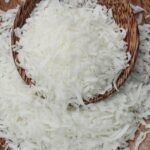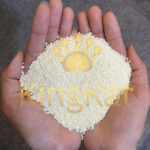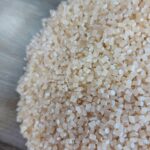CASHEW NUT SHELL OIL
As the global demand for aquaculture products continues to rise, the need for efficient and sustainable feed solutions becomes increasingly critical. Pregelatinized tapioca starch has emerged as a key ingredient in aquafeed formulations, offering several benefits that enhance feed performance, fish health, and environmental sustainability. This article delves into the application of pregelatinized tapioca starch in aquafeed, highlighting its importance with data-backed insights.

Table of Contents
ToggleWhat is Pregelatinized Tapioca Starch?
Pregelatinized tapioca starch is derived from the root of the cassava plant. Through a process of heating and drying, the starch undergoes partial gelatinization, making it soluble in cold water. This modification significantly improves its binding, thickening, and stabilizing properties, which are crucial in aquafeed production.
The Role of Pregelatinized Tapioca Starch in Aquafeed
Enhanced Pellet Stability
One of the primary functions of pregelatinized tapioca starch in aquafeed is to act as a binder. It improves the physical integrity of feed pellets, ensuring they remain intact during handling, storage, and in the aquatic environment. According to a study published in the Journal of Applied Aquaculture, the inclusion of pregelatinized starch in fish feed formulations can reduce pellet disintegration by up to 40%, leading to more efficient feeding and less waste in the water.
Improved Nutrient Delivery
Pregelatinized tapioca starch aids in the controlled release of nutrients. Its high viscosity helps to slow the passage of food through the digestive tract, allowing for better absorption of essential nutrients. This controlled release is particularly beneficial in fish species with fast digestive systems, ensuring they receive the full nutritional benefit from their feed. Data from the Food and Agriculture Organization (FAO) highlights that optimized nutrient delivery can lead to a 10-15% improvement in feed conversion ratios (FCR), directly impacting growth rates and reducing overall feed costs.
Sustainability and Environmental Impact
The use of pregelatinized tapioca starch also contributes to environmental sustainability in aquaculture. Traditional binders, often derived from synthetic sources, can leave harmful residues in water systems, negatively affecting aquatic life. Tapioca starch, being a natural and biodegradable product, mitigates this risk. Furthermore, research by the Aquaculture Stewardship Council (ASC) indicates that feed formulations utilizing tapioca starch result in a 20% reduction in water pollution compared to feeds using synthetic binders. This reduction in pollution is critical for maintaining healthy aquatic ecosystems and aligns with the growing demand for environmentally responsible aquaculture practices.
Cost-Effectiveness and Availability
In addition to its functional benefits, pregelatinized tapioca starch is cost-effective and readily available, particularly in tropical regions where cassava is abundantly cultivated. The economic advantage of using tapioca starch over other binding agents can be significant, especially for large-scale operations. The International Starch Institute reports that tapioca starch is 25-30% cheaper than traditional binders like wheat gluten or corn starch, offering a substantial cost saving in feed production without compromising quality.
Future Prospects: Innovation in Aquafeed Formulation
The demand for sustainable and efficient aquafeed ingredients is set to grow as the aquaculture industry continues to expand. Pregelatinized tapioca starch is poised to play an increasingly important role, not only as a binder but also as a contributor to the overall sustainability of aquaculture operations. Innovations in starch modification processes could further enhance its functionality, making it even more integral to advanced aquafeed formulations.
Conclusion
Pregelatinized tapioca starch is more than just a binder; it’s a multifunctional ingredient that supports the performance, health, and sustainability of aquaculture operations. Its ability to enhance pellet stability, improve nutrient delivery, reduce environmental impact, and offer cost savings makes it an invaluable component in modern aquafeed. As the aquaculture industry faces growing challenges and opportunities, ingredients like pregelatinized tapioca starch will be crucial in driving its success.
For aquafeed producers looking to optimize their formulations, incorporating pregelatinized tapioca starch is a strategic choice that promises both economic and ecological benefits.












